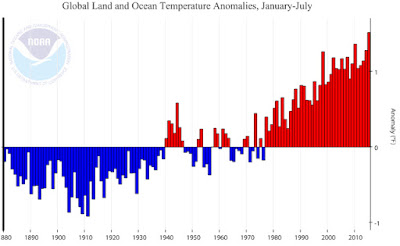28 August 2015, The Guardian, Extreme Arctic sea ice melt forces thousands of walruses ashore in Alaska. Survival of walruses threatened as they wash ashore on a remote barrier island just before Obama is due to visit region to draw attention to climate change. The extreme loss of Arctic sea ice due to climate change is forcing thousands of walruses to crowd ashore on a remote barrier island off Alaska, and threatening their survival. Barack Obama will be the first US president to visit the Alaskan Arctic on 31 August on a three-day tour to draw attention to the drastic consequences of climate change for the Arctic, such as warming winters and the rapid retreat of sea ice. The first reported sighting of animals forced to come ashore in the Chukchi Sea was by a photographer on 23 August, and confirmed by villagers in the remote hamlet of Point Lay late on Thursday, the US Fish and Wildlife Service said. Such landings, forced by the absence of sea ice on which to rest and feed, put the animals at risk of stampede in the limited space of the barrier island. The animals are easily spooked by aircraft or onlookers, government scientists warned. Trampling deaths are one of the biggest natural risks. Sea ice cover in the winter months fell to a new low this year because of climate change and abnormal weather patterns. Read More here
Category Archives: Impacts Observed & Projected
26 August 2015, The Carbon Brief, Celebrating soils: Why are they so important for our climate? From the 800th anniversary of the Magna Cartato the 60th birthday of the Birds Eye Fish Finger, there are plenty of reasons to mark 2015 as an important year. But you could be forgiven for being unaware that 2015 is also theUN International Year of Soils. By putting soils centre stage, the UN Food and Agricultural Organisation (FAO) aims to raise awareness of how important soils are for producing food and fuel, and keeping ecosystems healthy. But soils have also been thrust to the forefront of international science because of climate change. Globally, the top metre of soils contains about three times as much carbon as in our entire atmosphere. Losing carbon from the soil into the atmosphere can add to climate warming. But if soils can be managed in a way that means they store more carbon, they can help to reduce the amount of carbon in the atmosphere, and thereby help limit climate change. Read More here
26 August 2015, NASA The fingerprints of sea level rise. When you fill a sink, the water rises at the same rate to the same height in every corner. That’s not the way it works with our rising seas. According to the 23-year record of satellite data from NASA and its partners, the sea level is rising a few millimeters a year — a fraction of an inch. If you live on the U.S. East Coast, though, your sea level is rising two or three times faster than average. If you live in Scandinavia, it’s falling. Residents of China’s Yellow River delta are swamped by sea level rise of more than nine inches (25 centimeters) a year. These regional differences in sea level change will become even more apparent in the future, as ice sheets melt. For instance, when the Amundsen Sea sector of the West Antarctic Ice Sheet is totally gone, the average global sea level will rise four feet. But the East Coast of the United States will see an additional 14 to 15 inches above that average. Read More here
24 August 2015, Climate Code Red, As 2015 smashes temperature records, it’s hotter than you think. There is an El Nino in full swing which helps push average global temperatures higher, and records are being broken, but just how hot is it? For several years, we have heard that global warming has pushed temperatures higher by around 0.8 to 0.85 degrees Celsius (°C). But in 2015, that number is not even close. Even before this year’s strong El Nino developed, 2015 was a hot year. The first few months of the year broken records for the hottest corresponding period in previous years all the way back to the start of the instrumental record in 1880. Each month, new records fell.
With the July data in, the US Government’s National Oceanic and Atmospheric Administration reported that July was the hottest month among the 1627 months on record since 1880, and the first seven months of the year was the hottest January-July on record: The July average temperature across global land and ocean surfaces was 0.81°C above the 20th century average. As July is climatologically the warmest month for the year, this was also the all-time highest monthly temperature in the 1880-2015 record, at 16.61°C, surpassing the previous record set in 1998 by 0.08°C. The July globally-averaged sea surface temperature was 0.75°C above the 20th century average. This was the highest temperature for any month in the 1880-2015 record, surpassing the previous record set in July 2014 by 0.07°C. The global value was driven by record warmth across large expanses of the Pacific and Indian Oceans. The year-to-date temperature combined across global land and ocean surfaces was 0.85°C above the 20th century average. This was the highest for January-July in the 1880-2015 record, surpassing the previous record set in 2010 by 0.09°C. As 2015 smashes temperature records, it’s hotter than you think. Read More here

